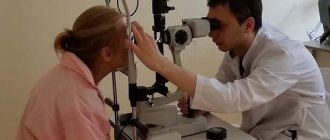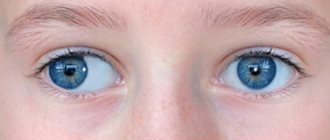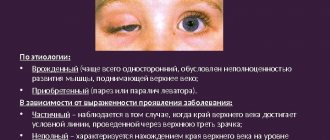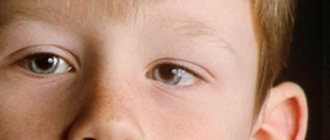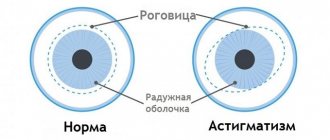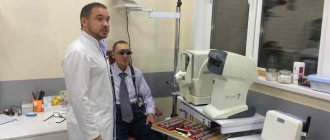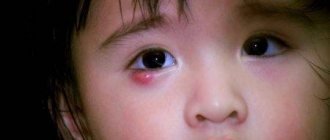- Photo-Video
- Reviews
- Articles
- Licenses
- Work with us
- Insurance partners
- Partners
- Controlling organizations
- Schedule for receiving citizens for personal requests
- Online consultation with a doctor
- Documentation
Strabismus is a position of the eyes in which the visual axes do not converge on the object in question. Outwardly, this is manifested by the fact that the eye deviates in one direction or another (to the right or left, less often up or down, and various combined options are also found).
If the eye is brought to the nose, the strabismus is called convergent (more common), and if it is brought to the temple - divergent. One eye or both may squint. Most often, parents turn to a pediatric ophthalmologist after noticing that the child’s eyes are looking “wrong.”
Strabismus is not just a problem of appearance. The effect of strabismus is a consequence of disturbances in the perception and conduction of visual information throughout the child’s visual system.
With strabismus in children, visual acuity decreases, connections between the right and left eyes are disrupted, as well as the correct balance between the muscles that move the eyes in different directions. In addition, the ability for three-dimensional visual perception is impaired. Strabismus can be congenital, but more often it occurs in early childhood. If the pathology appears before 1 year of age, then it is called early acquired. The disease may also appear at 6 years of age. But more often strabismus develops between the ages of 1 and 3 years.
At birth, the child does not yet know how to look with “two eyes”; the ability to binocular vision develops gradually until the age of 4 years. In this case, any deviation of the visual axis from the point of fixation should be qualified as strabismus and under no circumstances be considered as a variant of the norm. This applies even to such seemingly cosmetically minor cases as small-angle strabismus and unstable strabismus.
Most often, strabismus develops in children with farsightedness - when the baby has difficulty seeing objects that are close. But strabismus can also develop in children with astigmatism.
With astigmatism, some areas of the image may be focused on the retina, others behind or in front of it (there are also more complex cases). As a result, the child sees a distorted image. You can get an idea of this by looking at your reflection in an oval teaspoon. The same distorted image is formed with astigmatism on the retina. But although the picture itself with astigmatism may be blurry and indistinct, the child is usually not aware of this distortion, since the brain “corrects” his perception. Strabismus can also occur with myopia - when the child has difficulty seeing objects located in the distance.
When strabismus occurs in a constantly squinting eye, visual acuity gradually decreases - amblyopia. This complication is due to the fact that the visual system, in order to avoid chaos, blocks the transmission to the brain of the image of the object that the squinting eye perceives. This condition leads to an even greater deviation of this eye, i.e. strabismus intensifies.
The process of vision loss depends on the age of onset of the pathology. If this happened in early childhood, in the first year of life, then the decrease in visual acuity can be very, very rapid.
The causes of strabismus can be:
- hereditary predisposition, when close relatives (parents, uncles, aunts, etc.) have the disease;
- the presence of one or another optical defect (defocusing) of the child’s organ of vision, for example, with farsightedness in children;
- various intoxications (poisonings) of the fetus during pregnancy;
- severe infectious diseases of the child (for example, scarlet fever, diphtheria, etc.);
- neurological diseases.
In addition, the impetus for the occurrence of strabismus in a child (against the background of prerequisites) can be high temperature (over 38°C), physical or mental trauma.
Strabismus in children under one year of age: causes
- A disease of the central nervous system can lead to the development of pathology in a child;
- Infectious diseases or mechanical injuries suffered at an early age can also cause strabismus;
- If at least one of the parents suffers from the disease we are considering, then the risk of developing this disease in the child increases threefold;
- Occasionally, fetal hypoxia that occurs directly during childbirth also affects the condition of the child’s visual organs;
- Damage to nerve endings;
The main thing is not to confuse true strabismus with its imaginary form. We are talking about the peculiar location and shape of a newborn’s eyes. For this reason, in some children with a widened bridge of the nose, the position of the eyes strongly resembles strabismus, and parents begin to panic because of this. There is nothing wrong with this; as a rule, children grow up, their nose bridge straightens, and at the same time the unpleasant deviation disappears. However, the true causes of strabismus in children can only be determined by an ophthalmologist, so to confirm or refute doubts about the development of pathology in a child, you need to contact him.
Causes of the disease
Children's strabismus in the first period of life is a physiological feature that is characterized by transitivity. This is explained by the fact that newborn children have a rather weak optic nerve. The baby cannot control his vision, which is why a pathological condition may appear. It should not cause concern to parents, as it can go away on its own before the age of 6 months.
If strabismus in babies after birth is characterized by the absence of other ophthalmological pathologies, then this is the norm. When the disease appears at the age of more than 2 years, it is necessary to carry out its correction. In a child aged 2 years and older, the onset of the disease can be observed for a variety of reasons. Quite often it accompanies other ophthalmological diseases in the form of:
- conjunctivitis;
- farsightedness;
- cataracts;
- stye on the eye;
- myopia.
The occurrence of a pathological condition can be observed against the background of common ailments, for example, juvenile rheumatoid arthritis. Pathology at 11 years of age can be observed in neurological diseases. A fairly common cause of pathology is poisoning, which can have a variety of etiologies. With traumatic brain injuries in children 2 years of age, the onset of the disease may also occur.
Quite often it is observed that a child develops a pathology against the background of eye injuries.
If a child has one eye squinting, this may indicate birth injuries and fetal hypoxia. If the visual organs of children aged 11 years are subject to excessive stress, this can lead to illness. Quite often it is observed that a baby's eye squints after a fright.
There are many reasons why the disease appears in 2-year-old children. That is why parents need to be as attentive as possible to the health of their baby and regularly check the condition of the eyes.
Strabismus in children: symptoms
The main symptom in this case is a change in the position of the child's eyeball. If the baby looks clearly in front of him, but one or both of his eyes randomly deviate to the side, then in this case we can talk about strabismus. In medicine, there are various forms of this pathology:
- Divergent strabismus (in such cases, children’s eyes diverge in different directions towards the temples);
- Vertical strabismus (if you draw an even line from the beginning of the section of the left eye to the beginning of the section of the right eye, then one of the two visual organs will be slightly higher than the other, relative to the drawn line);
- Convergent strabismus (in this case we are talking about a shift of one or both eyes towards the bridge of the nose);
- Combined strabismus (may include several different forms of the disease described above);
- Paralytic strabismus (with this form of the disease the eye is partially or completely deprived of mobility);
Features of divergent strabismus
The following main problems of pathology are identified:
- cosmetic defect;
- impaired stereoscopic vision;
- a change in normal convergence - the ability to bring the eyes to the bridge of the nose.
Patients with this disease suffer from difficulty viewing objects, reading, and working. To see close objects, they need to turn their head to compensate for the angle of the squint. This, in turn, causes a number of other health problems - poor posture, scoliosis, circulatory failure in the vessels of the neck, and ischemic processes in the brain.
Also a serious problem is the difficulty in teaching children with divergent strabismus. Their health disorders directly affect cognitive processes and interfere with development.
It is known that six muscles control eye movements - four of them move the eyes along a trajectory up and down, and two are responsible for turning from one side to the other. The normal state of the oculomotor system implies consistency in muscle movements. Then the eyes work correctly, visual information accurately enters the brain, and after processing is perceived as a solid image. If at least one of the muscles begins to function abnormally, strabismus occurs. Most often, the pathology manifests itself in childhood, but can also occur due to a significant increase in visual load or after severe stress. Often strabismus occurs in a complex of symptoms of some specific disorders, for example, Down syndrome, cerebral palsy, various oncological diseases of the brain.
Often, children, due to strabismus, develop amblyopia - “lazy eye syndrome”, which is manifested by an abnormal reaction of the nervous system in the form of “switching off” the deviated eye from the processes of information perception.
Is it necessary to deal with strabismus in a child?
If you do not overcome this pathology in childhood, then later it will cause the child a lot of inconvenience. After all, modern children spend a huge amount of time on various multimedia entertainment (this means watching TV, playing on a computer or game console), and therefore their eyes must have full binocular vision and be resistant to increased loads.
Due to the lack of proper treatment, in some children the pathology is complicated by the development of amblyopia. This is a rather dangerous disease, as a result of which both the brain and the retina lose their functions associated with proper image processing. And most importantly, untreated strabismus begins to affect the child’s overall vision by about seven or eight years of age.
Causes
The reasons for the formation of exotropia can be various factors that directly or indirectly affect oculomotor functions. Also, the pathology can be congenital or acquired, depending on the period of life in which the disorder occurred.
Typically, the following common causes of divergent strabismus are identified:
- muscle development abnormalities;
- congenital disorders of fixation of muscle oculomotor structures;
- changes in refraction - the presence of farsightedness, myopia or high degree of astigmatism;
- significant decrease in visual acuity in one eye;
- post-traumatic conditions;
- diseases of the central structures of the nervous system;
- pathologies of the peripheral nervous system - paresis or paralysis;
- influence of stress;
- serious mental trauma;
- complications of infectious diseases - influenza, measles, diphtheria, scarlet fever;
- decompensated internal diseases.
It is important to understand that some of these conditions do not necessarily lead to the formation of divergent strabismus, but they create significant risk factors that can trigger pathological processes and cause diseases of the visual system.
The genetic factor also occupies a special place. There are theories that the tendency to strabismus is inherited, but clinically the pathology may not manifest itself in the absence of risk factors and compliance with preventive measures.
What should parents do?
First, you need to understand that during the first twelve months the child’s visual organs undergo primary formation, so strabismus in children under one year of age is considered normal, provided that no third-party ailments were identified by the ophthalmologist during the examination of the baby.
In the future, to prevent the development of the disease, it is recommended to show it to the same experienced ophthalmologist three times in the first twelve months of a newborn’s life.
- The baby should be shown to the doctor for the first time when he is one month old;
- The second campaign should take place in six months;
- The last visit to the ophthalmologist is at twelve months;
When a child is diagnosed with an illness, it is imperative to interview all the closest relatives and find out whether they had similar problems in childhood, and what reasons led to its appearance? And most importantly, you need to find out about the degree and form of the disease; with this information, it will be much easier for the doctor to make a diagnosis and prescribe effective treatment for the baby.
How is the disease treated?
Standard treatment of this disease always begins with conservative and instrumental methods. A sick child is prescribed special glasses and the healthy visual organ is covered with an occluder (cotton swab, bandage) for several hours every day. This is done so that the diseased eye develops more actively and catches up. For especially capricious children, instead of an occluder, special lenses with a positive diopter value are prescribed. They are put on the baby’s eyes several times a day throughout the treatment course.
In cases where conservative treatment is not enough, all further treatment measures are reduced to surgical intervention. During surgery, doctors usually try to correct the location of the eye muscles (recession) and change their length if necessary (resection). After surgical treatment, the visual functions of sick children are restored almost completely. In addition, with the help of special techniques and simulators, doctors completely rehabilitate the child’s ability to have stereoscopic vision.
Prevention of strabismus in children
- Children under one year old are strictly prohibited from watching TV.
- During games and entertainment, it is not recommended to show newborns various objects too closely. If you need to demonstrate something to your baby, the object should be held at a distance of thirty to forty centimeters from his face. Particular attention should be paid to toys consisting of several parts; they should be shown to the baby separately.
- During walks, you need to focus the baby's attention on moving objects. These could be cyclists, planes in the sky or ordinary cars. Initially, the baby will move his head in the direction of the movement of the object, but later he will understand that it is enough to follow the car or plane with his eyes.
- The baby must understand the concepts of near and far well. To do this, parents need to work with him regularly. Moreover, it won’t take much time to train. All parents need to do is move bright cubes or other objects closer and further away from the child’s face and towards the child’s face (no closer than thirty centimeters). However, we should not forget that children under one year old still have difficulty focusing on objects, so all movements should be as smooth and gliding as possible.
- You can play hide and seek with your baby. To do this, you need to close one eye with your hand and watch the baby with your free eye, thereby showing him an example. The child must complete a similar exercise to the best of his ability.
By following our recommendations, you can easily protect your child from an unpleasant illness. In addition, the above exercises are very popular with kids and they treat them as games. The main thing is to set an example for the child so that he sees the guideline and follows it.
Symptoms
The main sign of strabismus (strabismus) of the divergent type is a noticeable deviation of the eye outward. However, in the initial stages of the disease, such a symptom may not be noticeable. Often a child's eye squints in moments of stress, fatigue, or visual strain, so those around him do not focus attention on him. Another deviation of the eye from the bridge of the nose can occur when viewing objects at a long distance.
Divergent strabismus can also make itself felt by other symptoms:
- squinting while looking at objects;
- I want to rub my eyes;
- rapid fatigue during visual stress;
- double vision when looking at objects;
- attempts to close the eye while looking at objects.
Also, over time, the symptoms increase, the eye begins to deviate when looking at objects near and far, and then may stop returning to a straight position. The result of the lack of timely treatment for divergent strabismus is a complete loss of binocular vision.
